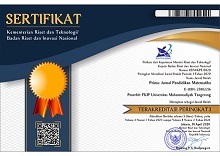DEVELOPMENT OF STEAM-BASED E-LKPD TO IMPROVE CREATIVE THINKING SKILLS ON GEOMETRY TRANSFORMATION MATERIAL
Abstract
Keywords
Full Text:
PDFReferences
Arifin, A. M., Pujiastuti, H., & Sudiana, R. (2020). Pengembangan Media Pembelajaran STEM Dengan Augmented Reality Untuk Meningkatkan Kemampuan Spasial Matematis Siswa. Jurnal Riset Pendidikan Matematika, 7(1), 59–73.
Handayani, W., Kuswandi, D., Akbar, S., & Arifin, I. (2023). Pembelajaran Berbasis STEAM Untuk Perkembangan Kognitif Pada Anak. Murhum : Jurnal Pendidikan Anak Usia Dini, 4(2), 770–778. https://doi.org/10.37985/murhum.v4i2.390
Hapsari, G. P. P., & Zulherman, Z. (2021). Pengembangan Media Video Animasi Berbasis Aplikasi Canva Untuk Meningkatkan Motivasi Dan Prestasi Belajar Siswa. Jurnal Basicedu, 5(4), 2384–2394.
Hasanah, A., Hikmayani, A. S., & Nurjanah, N. (2021). Penerapan Pendekatan STEAM Dalam Meningkatkan Kreativitas Anak Usia Dini. Jurnal Golden Age, 5(02), 275–281.
Hasibuan, A. T., & Prastowo, A. (2019). Konsep Pendidikan Abad 21: Kepemimpinan Dan Pengembangan Sumber Daya Manusia SD/MI. MAGISTRA: Media Pengembangan Ilmu Pendidikan Dasar Dan Keislaman, 10(1), 26–50. https://doi.org/10.31942/mgs.v10i1.2714
Nuragnia, B., Nadiroh, & Usman, H. (2021). Pembelajaran Steam Di Sekolah Dasar : Implementasi Dan Tantangan. Jurnal Pendidikan Dan Kebudayaan, 6(2), 187–197. https://doi.org/10.24832/jpnk.v6i2.2388
OECD. (2023). PISA 2022 Results (volume I): The State of Learning and Equity in Education. OECD Publishing Paris.
Prastika, Y., & Masniladevi, M. (2021). Pengembangan E-LKPD Interaktif Segi Banyak Beraturan Dan Tidak Beraturan Berbasis Liveworksheets Terhadap Hasil Belajar Peserta Didik Kelas IV Sekolah Dasar. Journal of Basic Education Studies, 4(1), 2601–2614.
Rahayu, E. L., Akbar, P., & Afrilianto, M. (2019). Pengaruh Metode Mind Mapping Terhadap Strategi Thinking Aloud Pair Problem Solving Terhadap Kemampuan Berpikir Kreatif Matematis. Journal On Education, 01(02), 271–278.
Rozi, F. A., & Afriansyah, E. A. (2022). Analisis Kemampuan Berpikir Kreatif Matematis Berdasarkan Disposisi Matematis Siswa. 4(2), 172–185.
Sarman, A. A., Suastika, I. K., & Murniasih, T. R. (2023). Pengembangan E-LKPD Untuk Meningkatkan Kemampuan Pemecahan Masalah Matematis Peserta Didik Pada Materi Bangun Ruang Sisi Lengkung. Jurnal Tadris Matematika, 6(1), 49–66. https://doi.org/10.21274/jtm.2023.6.1.49-66
Septikasari, R., & Frasandy, R. N. (2018). Keterampilan 4C Abad 21 Dalam Pembelajaran Pendidikan Dasar. Tarbiyah Al-Awlad: Jurnal Kependidikan Islam Tingkat Dasar, 8(2), 107–117.
Soeviatulfitri, K. (2020). Kemampuan Berpikir Kreatif Matematis Siswa melalui Model Problem Based Learning ( PBL ) dan Model Pembelajaran Osborn di SMP. Jurnal Pendidikan Matematika Raflesia, 05(03), 35–43.
Subakti, D. P., Marzal, J., & Hsb, M. H. E. (2021). Pengembangan E-LKPD Berkarakteristik Budaya Jambi Menggunakan Model Discovery Learning Berbasis STEM untuk Meningkatkan Kemampuan Berpikir Kreatif Matematis. Jurnal Cendekia: Jurnal Pendidikan Matematika, 5(2), 1249–1264.
Sugiyono. (2013). Metode Penelitian Kuantitatif Dan Kualitatif Serta R&D. In Alfabeta, CV (Issue April).
Suparman, T., & Zanthy, L. S. (2019). Analisis Kemampuan Berpikir Kreatif Matematis Siswa SMP. Journal On Education, 01(02), 503–508.
Wening, T. C., & Hayuhantika, D. (2023). Pengembangan LKPD dengan Pendekatan STEAM melalui Model PjBL untuk Menumbuhkan Keterampilan Berpikir Kreatif pada Materi Lingkaran Kelas VIII. Jurnal Tadris Matematika, 6(2), 245–262.
Widiyani, A., & Pramudiani, P. (2021). Pengembangan Lembar Kerja Peserta Didik (LKPD) Berbasis Software Liveworksheet Pada Materi PPKn. Jurnal Riset Pedagogik, 5(1).
DOI: http://dx.doi.org/10.31000/prima.v9i2.14204
Article Metrics
Abstract - 880 PDF - 407Refbacks
- There are currently no refbacks.
Prima: Jurnal Pendidikan Matematika
Program Studi Pendidikan Matematika
Fakultas Keguruan dan Ilmu Pendidikan
Universitas Muhammadiyah Tangerang
Jl. Perintis Kemerdekaan I/33, Cikokol
Kota Tangerang, Indonesia
e-mail: primajpm@gmail.com
Prima: Jurnal Pendidikan Matematika (p-ISSN: 2579-9827 | e-ISSN: 2580-2216) is licensed under a Creative Commons Attribution 4.0 International License.







